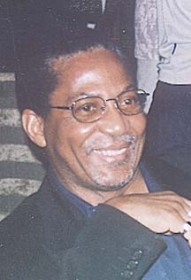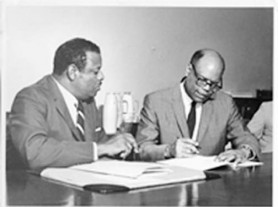The Caribbean Development Bank (CDB) is celebrating its 40th anniversary basking in the glow region-wide acclaim. At the bank’s recently concluded Fortieth Annual Meeting of its Board of Governors in Nassau four Caricom prime ministers, a deputy prime minister and two premiers and chief ministers each of dependent Caribbean territories were on hand to pay tribute to the accomplishments of the institution which its serving President Dr Compton Bourne said in his feature address “faced the spectre of disintegration and diminution” just a decade ago.

Just how far the CDB has come in those ten years is reflected in an impressive contemporary portfolio. Founded with an initial authorized capital stock of US$50 million the bank has disbursed in excess of US$3.3 billion in loans and grants to its borrowing member countries while retaining a Triple ‘A’ rating. “To say that the bank has proven its worth in better enabling its BMCs to confront successive economic shocks and development challenges over the years is an understatement of the greatest order,” Guyana’s Finance Minister Dr Ashni Singh said in his address as alternate governor of the bank.
Just how far the CDB has receded from the brink of possible disintegration was underscored in Dr Bourne’s poignant and stirring address during which he alluded to “the tremendous anxiety felt in 2000” when France withdrew from the bank and both Germany and Italy declined to contribute to a general capital increase to the institution. Then, concerns centred around the costs associated with the administration of the bank and what Dr Bourne described as “impediments to disbursements stemming from inflexibility of procedures and rules.”
As Guyanese economist and Caricom Secretariat Observer Dr Maurice Odle noted in his address to the meeting, however, the critical role of the CBD in buttressing the fragile economies of the region was evident even in its formative years. Dr Odle noted that as early as the 1970s the bank had made some telling interventions, providing “compensatory financing to help offset the effects of the first energy price rise crisis.” A second energy crisis in the early 1980s required the CDB to duplicate its earlier effort while, as Odle also noted, loss of international market by the regional tourism industry saw the bank “respond to both the need for increased competitiveness in the industry and the critical public goods and human resource requirements for a more diversified national economic structure”. Subsequently, the bank was to make various telling interventions “with respect to deepening of the integration process” some of the best known of these being its financial role in the creation of the Caribbean Court of Justice and the Caricom Development Fund and its salvaging of the regional aviation institution, LIAT.

Dr Bourne, too, pointed to some key indicators of the plight in which the CDB had found itself. Noting that there was “little growth” in the bank’s loan portfolio between 1994 and 1997 Bourne said that during that difficult period the quality of relations between the CDB and Inter-American Development Bank were no more than “workable” that “access to funds from the IDB and the World Bank had ceased” and that “there certainly was a breakdown in working relationships between the CDB and the World Bank in 1999.”
Dr Bourne’s review of the nine years since 2001 indicates, he says, that the CDB’s response to the crisis was “strong and credible.” In this regard, he cites various critical reform measures in the management of the institution including a strengthening of relations between the bank and its member countries; a mending of fences with key multilateral financing agencies including the World Bank; the implementation of an Operations Audit which had considerable implications for performance monitoring; the reduction of the bank’s administrative expenses; the immersion of the bank “in the domains of national and regional economic policy: the expansion of the bank’s borrowing and non-borrowing membership; success in attracting more funds from member countries and revamped “policies and procedures for recruitment of managerial and professional staff.”
The worm may have turned but the CDB’s incumbent president cautions about any reckless assumption that the bank’s troubles are now firmly behind it. “As in all cases of fundamental institutional change,” he declared on May 19 in Nassau, “there must be conscious and determined efforts at consolidation of the changes if the danger of reversal is to be averted. Unless change is entrenched it is merely ephemeral – a fleeting disruption of the status quo. Furthermore, there must be recognition that there is still room for improvement.”

Last week’s approval by the bank’s Board of Gover-nors to increase the CDB’s ordinary capital by US$1 billion, the largest single expansion of resources in its history signals a strong restoration of faith in the institution. It comes, as Ogle points out, on the back of the current global financial and economic crisis that has probably done more than any previous challenge to test the capacity of the bank. Ogle argues that for all its challenges the CDB had more than held its own between October 2008 and March this year, distributing to dramatic restoration “as much as US$261 million made up of US$236 million in the form of loans and US$25 million in the form of grants, primarily for crisis mitigation purposes. Cumulatively, over the course of the 40-year period of its existence, up to the end of last year, the CDB disbursed around $2.75 billion.
Still, both Bourne and Ogle believe that more challenges lie ahead for the CBD, the latter pointing to a strong regional expectation that its financing trajectory will persist. “Even with the resources being pledged to the Caribbean by the International Monetary Fund (IMF) and other international institutions, it is estimated that the region’s financing gap will still exceed a few billion dollars in the medium term.”
Bourne believes that one of the critical challenges that will confront the bank in this the second decade of the twenty-first century is that of throwing in its lot to respond to the jobless growth across the region, an outcome of the period of financial and economic crisis with its “adverse effects on tourist arrivals in an remittances to, the Caribbean” and the expected “slow return to confidence on the part of foreign investors. Particularly in the hotel construction and the bauxite/alumina sector.”
Bourne sees a critical role for the CDB both “to provide resources to Caribbean governments for enhanced public goods” and “to small and medium-sized enterprises in the private sector for technology training, retooling and upgrading.” The private sector, Ogle believes, will need all the help that the bank can offer since, he asserts, businesses in the region are in the process of re-positioning themselves in an environment that is likely to be much more competitive than prior to the start of the crisis. “In particular, firms with a global reach are likely to employ various labour and other cost-saving innovations and also intensify efforts at product differentiation in both the goods and service sectors.”
Bourne is advocating intensified efforts on the part of the bank to render itself relevant in new ways to the developmental priorities of the region that it was created to serve by providing support for both public and private sector projects, hence he talks about the “possibilities” that repose in prospects for “guidance to clients; the design of templates for project preparation, appraisal, monitoring and evaluation and the review of sector strategic policies”.
This year, the presence in Nassau of China’s Minister of State for Finance Zhivargo Laing may well portend new opportunities for support for the bank from the world’s fastest growing economy and the CDB has not been slow to respond to the opportunity. The bank is among a number of regional institutions, including governments, that are participating in the May 1 to October 31 Shanghai World Expo 2010. According to a release from its secretariat, “the bank views its participation as an important demonstration of support for this major undertaking by one of its non-borrowing members, China and for the efforts of its participating borrower member countries to attract tourism and foreign direct investment.”
It is of course, much more than a matter of demonstrating support for China. Apart from the fact that the bank cannot afford to disregard the importance of the resources which China brings to the institution, its presence in Shanghai reflects an energetic pursuit of what appears a renewed determination to present itself as an important face of the Caribbean.





